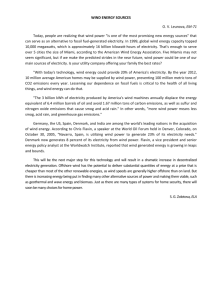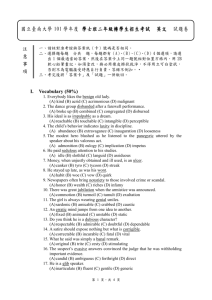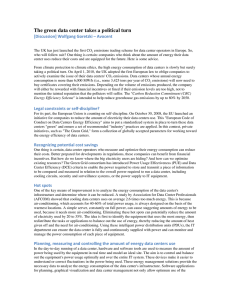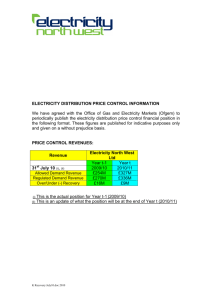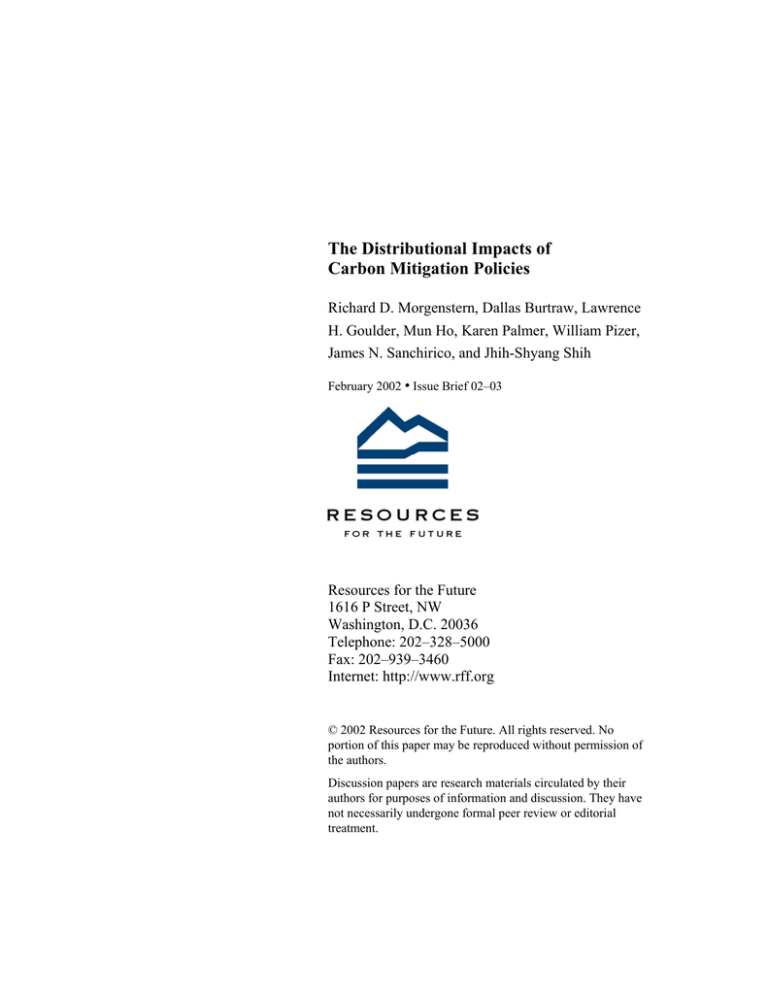
The Distributional Impacts of
Carbon Mitigation Policies
Richard D. Morgenstern, Dallas Burtraw, Lawrence
H. Goulder, Mun Ho, Karen Palmer, William Pizer,
James N. Sanchirico, and Jhih-Shyang Shih
February 2002 • Issue Brief 02–03
Resources for the Future
1616 P Street, NW
Washington, D.C. 20036
Telephone: 202–328–5000
Fax: 202–939–3460
Internet: http://www.rff.org
© 2002 Resources for the Future. All rights reserved. No
portion of this paper may be reproduced without permission of
the authors.
Discussion papers are research materials circulated by their
authors for purposes of information and discussion. They have
not necessarily undergone formal peer review or editorial
treatment.
Contents
I. Introduction ......................................................................................................................... 1
II. Economywide Analysis ...................................................................................................... 2
III. Manufacturing: Short-Term, Disaggregate Approach................................................. 5
IV. The Electricity Sector....................................................................................................... 8
V. Regional Impacts.............................................................................................................. 10
References.............................................................................................................................. 14
The Distributional Impacts of Carbon Mitigation Policies
Richard D. Morgenstern, Dallas Burtraw, Lawrence H. Goulder, Mun Ho, Karen Palmer,
William Pizer, James N. Sanchirico, and Jhih-Shyang Shih
I. Introduction
Who will pay for new policies to reduce carbon dioxide (CO2) and other greenhouse gas
emissions in the United States? Over the past several years, considerable strides have been made
in understanding the aggregate, economywide costs of policies designed to reduce greenhouse
gas emissions. Yet little attention has been paid to the distribution of these costs across
households, geographic regions, or industries. Not surprisingly, disagreements on the magnitude
of the costs imposed on different groups—urban versus rural households, rich versus poor
households, or the electric utility versus coal mining versus steel industries—can stymie efforts
to reach consensus on basic greenhouse gas mitigation strategies. Disagreements on the
distribution of the burden also can impede the development of policies to offset the economic
damages endured by particular groups or industries. Such disagreements over the basic facts
compound the already difficult problems associated with reaching consensus on carbon
mitigation policies. As Mancur Olson (1965) argued almost four decades ago, the more narrowly
focused the adverse impacts of a given policy, the more politically difficult it is to sustain that
policy. Claims of high and unfair burdens imposed on selected industries or households are
widely seen as having doomed the British thermal unit (Btu) tax advanced by the Clinton
Administration in 1993. An ongoing problem for policymakers regarding energy and carbon
policies is the dearth of objective and transparent estimates of the impacts of carbon policies; to
this day there is still disagreement on the true magnitude of the burdens that would have been
imposed by the Btu tax.
This issue brief reports on the results of four papers, each of which examines a different
aspect of the question of who will pay for mandatory carbon mitigation policies that might be
adopted by the United States. These papers were presented on December 11, 2001, at an RFF
workshop titled “The Distributional Impacts of Carbon Mitigation Policies: Various Lenses on
the Issue.” One of the papers focuses exclusively on the impacts carbon mitigation policies might
have on U.S. households by region, including state and county-level analyses. The other three
1
Resources for the Future
Morgenstern et al.
examine impacts on industry, each through a somewhat different lens. Two types of carbon
mitigation policies are considered: an economywide carbon mitigation policy, such as a carbon
tax or an upstream emissions trading system; and a downstream policy focused exclusively on
the electric power industry, such as the one contained in S.556. An important finding of these
analyses is that the burdens of a carbon mitigation policy fall very unevenly across population
and industry groups. Another conclusion is that without significant cost to the overall economy,
compensatory schemes can be introduced to make the distributional impacts more uniform,
avoiding the concentration of costs on a few key industries. This knowledge may enhance the
political feasibility of future carbon mitigation policies.
II. Economywide Analysis
The first paper, “Mitigating the Adverse Impacts of CO2 Abatement Policies on EnergyIntensive Industries,” by Larry Goulder, professor of economics at Stanford University and
University Fellow at Resources for the Future, uses a numerically solved general equilibrium
model to examine the economywide costs of mitigating adverse distributional impacts of CO2
policies on important fossil fuel industries. Goulder finds that the efficiency cost of avoiding
profit losses to fossil fuel industries is relatively modest. Underlying this finding is the
recognition that some important CO2 abatement policies, such as a cap-and-trade system
involving carbon permits, tend to restrict the output of carbon-intensive industries. Such outputrestricting policies cause carbon-supplying industries to behave like a cartel, potentially leading
to economic gains, or rents. If the tradable permits are auctioned, then these potential rents are
collected as government revenue. On the other hand, if the permits are freely allocated (or
grandfathered), the potential rents are retained by firms and yield increases in profit. To create a
level playing field, the government needs to freely allocate only a fraction of the permits. Based
on his model simulations, Goulder finds that only about 13% of the permits must be freely
distributed to the major affected industries in order to prevent losses of profit. The remainder of
the permits can be auctioned, thus generating revenues to finance cuts in pre-existing
distortionary taxes—thereby offsetting the adverse effects of the new CO2 policies.
The analysis conducted by Goulder is an updated version of work he has carried out with
Lans Bovenberg of Tilburg University in the Netherlands. It divides U.S. production into 13
2
Resources for the Future
Morgenstern et al.
industries. A distinguishing feature of the model is its attention to the adjustment costs associated
with the installation or reallocation of physical capital. The model links these costs to investment
decisions and profits. This contrasts with most computable general equilibrium models, which
treat physical capital as perfectly mobile across industries. Attention to adjustment costs is
necessary to evaluate the impacts of CO2 mitigation policies on industry profits. In the revised
version, Goulder has retained his original structure but updated the work to include data for the
year 2000.1
In his paper, Goulder examines a number of carbon tax and permits policies. All the
carbon tax scenarios start at $25 per ton of carbon. Several involve an escalating carbon tax that
reaches as high as $50 per ton. In the cases without earmarked compensation to particular fossil
fuel industries, the revenues are rebated as either lump-sum transfers to households or reductions
in marginal rates of the personal income tax. Alternative permit policies include 100% auction,
100% free allocation (“grandfathering”), and partial grandfathering.
Goulder’s central results are shown in Table 1 (page 15), which displays ten policy
scenarios. The first three scenarios involve imposition of a carbon tax with alternative revenuerecycling schemes but no compensation earmarked to specific industries. The next three
scenarios involve imposition of a tradable permits policy with alternative policies for distributing
the permits. The final four scenarios introduce corporate tax credits designed to achieve profit
neutrality in the hardest-hit industries.
Column A1 represents the case of a $25 per ton carbon tax imposed in 2002 and
remaining constant in real terms thereafter, with revenues rebated as a lump-sum transfer to
households. In the absence of specific compensation policies, the industries experiencing the
largest percentage reductions in 2002 after-tax profits are (in descending order) coal mining,
petroleum refining, electric utilities, oil and gas, and metals and machinery (rows 1–5). In the
coal mining industry, for example, after-tax profits initially decline by more than one-third in
2002; by 2025, after-tax profits are down slightly more than one-quarter. The average decline in
after-tax profits for all other industries is shown in row 6. Rows 7 and 8 display the efficiency
1
The 2000 data indicate that the carbon intensity of some fossil fuel industries has increased somewhat compared
3
Resources for the Future
Morgenstern et al.
impact of the $25 per ton carbon tax, using the equivalent variation measure.2 The $25 per ton
carbon tax implies a gross efficiency loss of approximately $104 per ton of emissions reduced,
which is equivalent to 56 cents per dollar of discounted gross tax revenue. Row 9 displays the
percentage change in carbon emissions compared with the baseline.
Perusal of the alternative tax and permit policies examined by Goulder (columns A1–3
and B1–3) reveals several interesting results. For example, consistent with other analyses,
Goulder finds that rebating the revenues via reductions in distortionary taxes, such as marginal
personal income tax rates, significantly reduces the total economic cost compared with the case
of lump-sum rebates. Columns B2 and B3 illustrate the implications of grandfathering some or
all of the permits. Column B3 shows that grandfathering 100% of the permits leads to substantial
gains for the coal mining and oil and gas industries. This policy enables firms to retain all the
rents associated with the policy-induced restriction in fossil fuel output. Column B2 gives results
from grandfathering about 13% of the permits—just enough to prevent losses of profits in the
coal and oil and gas industries. This policy is considerably less costly to the overall economy
than 100% grandfathering. Although 100% grandfathering raises efficiency costs by 90%
relative to the cost under the policy of 100% auctioning (column B1), the policy of partial
grandfathering in column B2 raises costs by only 7%. The partial grandfathering policy is less
costly because it yields more government revenue and thus reduces the government’s need to
raise revenue from other taxes.
Goulder also considers the use of targeted corporate tax credits designed to achieve profit
neutrality in the hardest-hit industries. The efficiency cost of compensating the coal mining
industry is $87.2 per ton of carbon reduction (column C1), 1.5% more than the efficiency cost of
not compensating that industry.3 Insulating other major industries from losses in after-tax profits
involves only small additional losses in terms of economic efficiency. As shown in column C4,
with the previous decade.
2
This is a gross measure because the numerical model does not account for the benefits associated with the
environmental improvement from reduced emissions. The negative of the equivalent variation is the gross efficiency
cost, or loss.
3
This efficiency cost reflects the fact that the tax credits absorb government revenue; hence the government must
rely more heavily on distortionary taxes than in the absence of the targeted corporate tax credits.
4
Resources for the Future
Morgenstern et al.
insulating the electric utility, petroleum refining, and metals and machinery industries increases
the efficiency cost by only an additional 0.3%.
Overall, Goulder argues, the cost of avoiding losses of profit to the hardest-hit (fossil
fuel) industries is relatively modest—less than 2% of the costs of not compensating them. When
other (smaller) industries are included in a safety net, as well as other groups outside the
industrial sector—for example, labor—the needed compensation will certainly rise. How much it
will rise is a matter requiring further research.
III. Manufacturing: Short-Term, Disaggregate Approach
A key strength of Goulder’s analysis is his effort to consider corporate profits as opposed
to only revenues. Much of his focus is on impacts five or more years from the time a new policy
is introduced. In the short term (the zero- to five-year horizon), however, firms cannot easily
remold their factories and machines in response to higher energy and other input costs. For a
variety of reasons, including competition from imports, firms may not be able to take immediate
advantage of the favorable market conditions caused by the carbon policy, and in fact, they may
not even be able to pass along all cost increases to their customers.
The second paper, “Near-Term Impacts of Carbon Mitigation Policies on Manufacturing
Industries,” by RFF’s Richard Morgenstern, Mun Ho, Jhih-Shyang Shih, and Xuehua Zhang,
concentrates on the cost impacts of CO2 policies in the short term. In this time interval, the costs
to a firm will roughly equal the per ton tax (or permit charge) multiplied by the current level of
carbon usage. For example, the cost of a $25 per ton carbon tax (or permit) to a firm that uses
100 tons of carbon is $2,500. Morgenstern et al. adopt a number of simplifications: they ignore
the effects of the carbon tax (or permit charge) on the quantity or type of capital and labor inputs
used, the effects of competition from imports, and any changes to tax laws and public spending
patterns that might be implemented in light of the new revenue from the carbon taxes (or
auctioned permits). Though lacking the elegance of the computable general equilibrium model,
the short-term analysis by Morgenstern et al. has the attraction of presenting information on the
distribution of costs at a large number of industries. Whereas Goulder is able to estimate the
effects of a carbon policy on the after-tax profits of 13 sectors, including 5 manufacturing
industries, Morgenstern et al. consider the increased costs borne by firms (not corporate profits)
5
Resources for the Future
Morgenstern et al.
across 361 separate manufacturing industries.4 Since capital and other factor inputs are frozen at
current levels, the Morgenstern et al. approach yields upper-bound estimates of total costs. Thus,
the results are best viewed as descriptive of the relative burdens within the manufacturing sector,
rather than as a measure of absolute costs.
Morgenstern et al. analyze two different policies: an economywide carbon mitigation
policy, such as a carbon tax or an upstream emissions trading system, and a downstream policy
focused exclusively on the electric utility industry. Two distinct steps are involved in the
analysis. First, a detailed picture of direct carbon (fuel) use by the 361 individual manufacturing
industries is developed. Second, interindustry accounts are constructed, including the final
demands for a detailed list of commodities. The latter step reveals indirect carbon use, such as
carbon embodied in nonfuel inputs. Using input-output analysis, it is possible to calculate the
total impacts on both consumer goods and on manufacturing industries of a carbon tax or
tradable permit system placed on primary fossil fuels (coal, crude oil, and natural gas). Since the
underlying model is linear, the results are reported as increases in overall production costs per
dollar of carbon tax imposed. The cost of a $25 per ton carbon tax is 25 times the cost of a $1
tax.
Figure 1 (page 19) displays the distribution of the percentage cost increases per dollar of
output across the 361 manufacturing industries associated with an economywide carbon policy.
This highly skewed picture reflects the basic conclusion of the Morgenstern et al. analysis: the
burden of an economywide carbon policy impacts the manufacturing sector quite unevenly. The
eight hardest-hit industries bear more than 50% of the total burden, measured as the cumulative
percentage of total costs. Among the entire list of 361 manufacturing industries, cost increases
vary by two orders of magnitude.
Table 2 (page 16) displays the 25 hardest-hit manufacturing industries by the sources of
the additional cost burdens. Particularly interesting is the variation in the sources of the burdens
4
Interestingly, Morgenstern et al. demonstrate a remarkable consistency between the results of their input-output
analysis and the computable general equilibrium models. They aggregate their results to the 21 manufacturing
categories examined by Ho and Jorgenson (1998) in their general equilibrium model of the U.S. economy. Nine of
their top 10 industries rank in Ho and Jorgenson’s top 10. The simple correlation coefficient between the two is
0.96, suggesting a high degree of consistency between the two approaches.
6
Resources for the Future
Morgenstern et al.
across different industries: direct combustion of fossil fuels, purchased electricity, and nonenergy
intermediate inputs. For example, in the case of petroleum refining, almost all of the increase in
total costs comes from increases in the cost of nonfuel intermediate inputs, mostly crude oil used
as a feedstock. Relatively minor contributions arise from increases in direct fuel costs or from
purchased electricity. In contrast, the cement (hydraulic) industry, direct combustion of fossil
fuels, and purchased electricity contribute more to total costs than nonenergy intermediate inputs.
Table 3 (page17) compares the impacts on manufacturing industries when an
economywide policy versus an electricity-only policy is imposed. The per ton charge on carbon
inputs is equal for the two policies. However, the former policy affects all carbon inputs, direct
and indirect, used in the manufacturing sector. The latter affects only carbon used in the
production of electricity, including the impact of the corresponding rise in electricity prices on
nonenergy intermediate inputs, such as the higher cost of aluminum car parts purchased by the
auto industry.
The left half of Table 3 displays the top 10 industries hardest hit by the economywide
policy and their corresponding ranking (among the 361 manufacturing industries) for the
electricity-only policy. Petroleum refining is hardest hit by the economywide policy, for
example, but ranks 145 under the electricity-only policy. Eight of the 10 industries hardest hit by
the economywide policy rank lower (or the same) for the electricity-only policy—in most cases
considerably lower.
The right half of Table 3 displays the 10 industries hardest hit by the electricity-only
policy along with their corresponding ranking for the economywide policy. The hardest hit—
aluminum—ranks number 13 for the economywide policy. All of the top 10 hardest hit under the
electricity-only policy rank lower or the same under the economywide policy—in many cases
substantially lower. The key conclusion of this exercise is clear: manufacturing industries are
affected very differently by these two policies. Many of those industries hardest hit by one policy
tend not to be so adversely affected by the other, and vice versa. Thus, opposition to these two
policies is likely to come from very different manufacturing industries.
7
Resources for the Future
Morgenstern et al.
IV. The Electricity Sector
The third paper, “The Effect of Allowance Allocation on the Cost of Carbon Emissions
Trading,” by RFF’s Dallas Burtraw, Karen Palmer, Ranjit Bharvirkar, and Anthony Paul, focuses
exclusively on the impacts of electricity-only carbon policies on the electricity sector. Burtraw et
al. consider the cost-effectiveness and distributional impacts of three alternative approaches for
distributing carbon emissions allowances within the electricity sector: 100% auctioning, 100%
free allocation or grandfathering, and a so-called generation performance standard (GPS), a form
of grandfathering that would update allowance allocations based on shares of current electricity
generation. The GPS standard is embodied in some current U.S. legislative proposals, such as S.
556, as well as in the nitrogen oxide (NOx) policy in place in Sweden. Interestingly, although the
electricity sector is responsible for just over one-third of U.S. carbon emissions, Burtraw et al.
report that based on various studies in the literature, the industry would be responsible for twothirds to three-quarters of the emissions reductions under a cost-effective economywide policy.
Burtraw et al. solve a detailed national electricity market model, known as Haiku, and
measure the economic cost and distributional effects on consumers and producers of each of the
three alternative approaches for distributing emissions allowances. The model includes
algorithms for investment and retirement of generation capacity and selection of NOx emissions
control technologies. It simulates electricity demand, electricity prices, the composition of
electricity supply, and emissions of major pollutants, including carbon. Generator dispatch in the
model is based on minimization of short-run variable costs of generation. Adjustments to
capacity are based on net revenues accounting for all costs, including new capital investments.
Two important components of the Haiku model are the intraregional electricity market
component and the interregional power-trading component. The intraregional electricity market
component solves for a market equilibrium identified by the intersection of price-sensitive
electricity demand for three customer classes (residential, industrial, and commercial) and supply
curves for four time periods (peak, shoulder, middle, and base load hours) in three seasons within
the 13 National Electricity Reliability Council (NERC) regions and subregions. Parameters for
each regional supply curve are established using cost estimates and capacity information for up
to 45 aggregate “model” plants. The interregional power-trading component solves for the level
of trading necessary to achieve equilibrium in regional electricity prices. These interregional
8
Resources for the Future
Morgenstern et al.
transactions are constrained by the assumed level of available interregional transmission
capability as reported by NERC.
Burtraw et al.’s main finding is that the auction is dramatically more cost-effective than
the other approaches—approximately one-half the societal cost of grandfathering or the GPS.
These differences, they argue, arise from the effect of each permit allocation approach on
electricity prices. The GPS provides an incentive for generators to increase electricity production
in the form of a grant of additional emissions allowances. These additional allowances constitute
an output subsidy.5 Although the GPS mitigates electricity price increases, it raises economic
costs, since it tends to amplify existing economic distortions in electricity markets resulting from
economic regulation and other inefficiencies in electricity pricing. In contrast, the auction
approach increases electricity prices the most, but the efficiency cost of the price changes is less
than under the other approaches.6
Table 4 (page 18) displays the changes in economic surplus and cost-effectiveness of the
three alternative approaches for distributing carbon emissions allowances examined by Burtraw
et al. (price changes are virtually proportional to changes in economic surplus). Under the
auction approach, consumers face the highest electricity prices but the lowest natural gas prices.
The GPS yields the opposite results: the lowest electricity prices and the highest natural gas
prices. Grandfathering falls in between with respect to both electricity and natural gas prices.
Producers can expect to do the best under grandfathering because it represents a
substantial transfer of wealth to producers from consumers. Consistent with Goulder’s results,
Burtraw et al. find that producer profits and asset values increase substantially compared with the
baseline, making producers better off with a carbon policy than without one but leaving
consumers substantially worse off. Even though grandfathering is the intermediate approach with
respect to its effect on electricity and natural gas prices, it is the most extreme approach with
5
Simulations by Burtraw et al. indicate that much of this subsidy persists even when utilities are able to receive
credit for energy conservation programs.
6
Under the auction policy examined by Burtraw et al., the revenues from the auction are returned to households as
lump-sum transfers. The authors point out that alternative revenue-recycling methods—for example, returning
revenues via cuts in marginal income tax rates (as in some of the experiments performed by Goulder)—could further
reduce the costs of the auction policy.
9
Resources for the Future
Morgenstern et al.
respect to transfers of wealth. In fact, the compensation implicit in the allowance allocation is
substantially greater than the cost of compliance activities for industry—that is, grandfathering
actually overcompensates industry for its costs. The auction and GPS approaches have much
more moderate distributional effects. In effect, under an auction, industry could be fully
compensated for all of the change in the value of the existing assets with a free allocation of less
than 10% of the total allowances, and the remaining 90% could be auctioned.
Producers can expect to do at least as well in the aggregate under an auction as they
would under a GPS, but owners of existing assets can expect to do substantially better under an
auction. This finding raises an interesting paradox: producers do better paying for emissions
allowances (through the auction) than receiving them for free (under the GPS). The reason for
this, according to Burtraw et al., is that the GPS yields the lowest electricity price, which erodes
the value of existing assets. The auction yields the highest electricity price, which preserves or
enhances the value of many assets.7
The auction approach also has institutional features that make it more readily expandable
to an economywide scheme for regulating carbon emissions. Apart from its lower societal cost,
the auction provides policymakers with flexibility through the collection of revenues that can be
used to meet distributional or other needs. Further, because it is so cost- effective, it will have
less effect on economic growth than would the alternative approaches when used to achieve the
same environmental goals. This, in itself, is an important distributional benefit.
V. Regional Impacts
The fourth paper, “Regional Patterns of Household Energy Use and Carbon Emissions,”
by RFF’s William Pizer, James Sanchirico, and Michael Batz, reports preliminary results
examining the regional patterns of household energy use and carbon emissions, and the
corresponding impacts of new carbon policies on the energy costs of different households across
7
Although consumer expenditures increase under the auction approach, substantial revenues are raised, which can
be used to compensate consumers. A portion of the revenues could also be used to compensate producers, or they
could be directed to support energy conservation or other benefit programs.
10
Resources for the Future
Morgenstern et al.
the United States. Despite its obvious importance, this issue has not been studied in great depth,
largely because the data needed to conduct such an analysis are sparse.
Pizer et al. use information from the Consumer Expenditure Survey over the period
1984–2000 as their starting point. Although the survey contains a sample of more than 90,000
households for this time period, the sampling technique only includes households from 666 of
the 3,140 U.S. counties. Thus, the key challenge for Pizer et al. is to model broad-scale and
regional patterns of energy and carbon use with such gaping holes in their data. In addition to the
counties with no data at all, they also want to allow for the fact that some of the sampled counties
have more observations than others and thus represent a more accurate measure of the energy use
in those counties. Pizer et al. address this challenge by employing the statistical technique of
nonparametric, kernel regression. This technique creates an estimate of the energy use at a
particular geographic point based on energy use at nearby, sampled points.8
Overall, Pizer et al. find considerable variation in the type of fuel used and the average
level of use across regions, across states within each region, and across counties within each
state. They note, based on data from the Energy Information Administration, that the typical U.S.
household spends about $2,500 per year on electricity, fuel oil, natural gas, and gasoline and
emits 4.4 tons of carbon per year. In general, the patterns they find conform to what one would
expect: electricity use is higher in the South, fuel oil is used almost exclusively in the Northeast,
and natural gas is more prevalent in the Midwest. Gasoline usage fluctuates modestly across
regions. What is surprising is the amount of heterogeneity both within states and within census
regions. For example, in Massachusetts, there is an approximately 70% difference in fuel oil use
between the highest- and lowest-consuming counties where the median county reports household
use around 300 gallons per year. In the South, the census region that has the highest levels of
average electricity use, the county averages vary by a factor of two.
Policies designed to reduce U.S. carbon emissions may (inadvertently) place heavier
burdens on regions where geography or history has led to higher carbon use per household.
Preliminary estimates of average household carbon emissions by county range from six tons per
8
Work in progress will incorporate information involving household characteristics that might influence energy use.
11
Resources for the Future
Morgenstern et al.
household in the Midwest to fewer than three tons per household in the Northwest. The principal
reason for this variance in emissions lies in the use of electricity and the ways in which it is
generated. Much of the Pacific Northwest’s power comes from hydroelectric plants. Similarly,
carbon emissions in the Northeast and in the South are lower because of their reliance on nuclear
power. Although there is less use of air conditioning in the Midwest than in the South, its carbon
emissions per household are higher than in other regions because such a large portion of its
electricity is generated by burning coal.
Given these preliminary findings on patterns of energy use and carbon emissions, Pizer et
al. find that adoption of a broad-based carbon policy—equivalent to a carbon tax or a tradable
permit system—would impose significantly different burdens on households in different regions
of the country. For example, households in the Northwest would pay about half as much as those
in the Midwest and Texas, where household emissions are almost double (see Figure 2, page20).
VI. Conclusions
The four papers presented at the December 2001 RFF Workshop address the critical
questions of who will pay for policies designed to reduce CO2 and other greenhouse gas
emissions in the United States. Key issues for discussion involve the magnitude of compensation
that might be justified for different sectors or groups, the form of such compensation, and the
institutions that may be involved. Although the four papers differ markedly in scope and
approach, a number of conclusions can be drawn from the analyses:
•
The cost burden of potential carbon mitigation policies is very unevenly distributed
across U.S. industries. Absent new compensation schemes, a small number of
industries would bear most of the costs. Not surprisingly, a different (small) set of
industries is affected by electricity-only compared with economywide policies.
•
Through the free provision (or grandfathering) of carbon permits, or through explicit
compensation schemes, the distribution of the cost burden of carbon mitigation
policies can be made more even. Avoiding uneven cost impacts does not add
significantly to the overall economic costs of carbon mitigation. According to one
paper, the free allocation (or grandfathering) of 13% of carbon permits would prevent
losses of profit in the fossil-fuel supplying industries. Such a policy would involve
economywide costs about 8% higher than the standard policies. Another paper finds
that earmarking less than 10% of the revenues derived from a carbon tax or auctioned
12
Resources for the Future
Morgenstern et al.
permit policy that targeted just the electricity sector would be sufficient to fully
compensate firms in that sector.
•
Regarding electricity-only control policies, the formula for allocating permits within
the electricity-only sector has major implications for both total costs and the
distributions of the burdens. Interestingly, auctioned permits cost substantially less
than gratis forms of allocation, such as grandfathering or the generation performance
standard. Auctioned permits also have the potential for more favorable impacts on
consumers and on the electricity sector itself.
•
Regional patterns of household energy use and carbon emissions vary significantly
across the United States. Based on a new, highly disaggregated analysis of the
Consumer Expenditure Survey, it appears that households in some sections of the
country, notably the Midwest and Texas, would face heavier burdens than those in
other regions, dramatically so when compared with those in the Pacific Northwest.
The policy debates of the past decade make it abundantly clear that the development of
mandatory policies to reduce U.S. emissions of CO2 and other greenhouse gases is no simple
matter. To avoid the hyperbole of exaggerated claims of damage to one sector or another,
detailed analyses of who will pay is critical. The results reported in this paper are designed
to contribute to that research effort and, more broadly, to the evolving policy process.
13
Resources for the Future
Morgenstern et al.
References
Burtraw, Dallas, Karen Palmer, Ranjit Bharvikar, and Anthony Paul. 2001. The Effect of
Allowance Allocation on the Cost of Carbon Emission Trading. RFF Discussion Paper
01-30.
Goulder, Lawrence. 2001. Mitigating the Adverse Impacts of CO2 Abatement Policies on
Energy-Intensive Industries. Paper presented at RFF Workshop, The Distributional
Impacts of Carbon Mitigation Policies, December 11, 2001.
Ho, Mun S., and Dale W. Jorgenson. 1998. Stabilization of Carbon Emissions and International
Competitiveness of U.S. Industries. In Dale Jorgenson (editor), Growth Vol. 2: Energy,
the Environment, and Economic Growth. Cambridge, MA: MIT Press.
Morgenstern, Richard D., Mun S. Ho, Jhih-Shyang Shih, and Xuehua Zhang. 2001. Near Term
Impacts of Carbon Mitigation Policies on Manufacturing Industries. Paper presented at
RFF Workshop, The Distributional Impacts of Carbon Mitigation Policies, December 11,
2001.
Olson, Mancur, 1965. The Logic of Collective Action. Cambridge, MA: Harvard University
Press.
Pizer, William, James N. Sanchirico, and Michael Batz. 2001. Regional Patterns of Household
Energy Use and Carbon Emissions. Paper presented at RFF Workshop, The
Distributional Impacts of Carbon Mitigation Policies, December 11, 2001.
14
Resources for the Future
Morgenstern et al.
Table 1: Impacts of CO2 Abatement Policies
(Percentage changes from reference case)
Policies with no distributional
adjustments
Carbon taxes combined with corporate tax
credits
Constant carbon tax, lumpsum repl
Carbon tax growing at 7%,
lump-sum repl.
Carbon tax growing at 7%,
personal tax repl.
100% auctioning
Partial free allocation
(equity-value neutrality)
100% free allocation
Credits to coal and to oil
and gas
Add credits to electric
utilities
Add credits to petroleum
refining
Add credits to metals and
machinery
Permits policies
A1
A2
A3
B1
B2
B3
C1
C2
C3
C4
-35.6, -26.6
-4.8, -1.9
-8.3, -5.0
-6.2, -3.7
-2.7, -2.6
-1.0, -1.3
-38.6, -40.5
-6.4, -5.5
-9.2, -9.8
-6.8, -6.9
-2.8, -4.5
0.0, -2.5
-38.0, -40.0
-6.5, -5.5
-8.4, -9.1
-5.4, -6.2
-1.4, -3.5
-0.1, -1.8
-38.0, -40.0
-6.5, -5.5
-8.4, -9.1
-5.4, -6.2
-1.4, -3.5
-0.1, -1.8
-23.0, -19.9
-2.8, -1.5
-8.4, -9.1
-5.5, -6.3
-1.3, -3.4
-0.2, -1.8
154.9, 217.6
19.9, 22.3
-8.7, -9.3
-6.0, -6.5
-1.0, -2.3
-0.6, -2.2
-38.0, -40.0
-6.5, -5.5
-8.5, -9.1
-5.5, -6.2
-1.5, -3.5
-0.2, -1.8
-38.0, -40.0
-6.5, -5.5
-8.4, -9.1
-5.5, -6.2
-1.5, -3.5
-0.2, -1.8
-38.0, -40.0
-6.5, -5.5
-8.5, -9.1
-5.5, -6.2
-1.5, -3.5
-0.2, -1.8
-38.0, -40.0
-6.5, -5.5
-8.5, -9.1
-5.5, -6.2
-1.5, -3.5
-0.2, -1.8
Absolute
1190.0
2228.0
1478.0
1478.0
1591.0
2810.0
1501.4
1504.8
1506.0
1506.2
Per ton of CO2 reduction
104.2
126.7
85.9
85.9
92.3
160.5
87.2
87.4
87.5
87.5
-14.84
-22.85
-22.35
-22.36
-22.39
-22.74
-22.38
-22.38
-22.38
-22.38
After-tax profits (2002, 2025)
Coal mining
Oil and gas
Petroleum refining
Electric utilities
Metal and machinery
Average for other industries
Efficiency cost
Emissions
Percentage change
Source: Goulder (2001).
15
Resources for the Future
Morgenstern et al.
Table 2: Estimated Percentage Increase in Manufacturing Costs, Top 25 Industries, per Dollar of Carbon Charge
Percentage
change in total
cost
Petroleum refining
0.718
Products of petroleum and coal
Rank
Cumulative
percentage
Percentage
change in fuel
cost
1
0.485
0.050
0.358
2
0.486
0.005
Lubricating oils and greases
0.259
3
0.492
Carbon black
0.254
4
0.493
Industry
Rank
Percentage change in
cost of purchased
electricity
Rank
Percent
Change in
Indirect Cost
5
0.005
76
0.663
1
53
0.006
50
0.347
2
0.070
3
0.001
315
0.189
5
0.023
12
0.020
7
0.211
4
Rank
Asphalt paving mixtures and blocks
0.220
5
0.498
0.004
69
0.004
95
0.212
3
Lime
0.196
6
0.499
0.090
1
0.025
5
0.082
10
Nitrogenous and phosphatic fertilizers
0.186
7
0.505
0.046
7
0.013
21
0.127
7
Asphalt felts and coatings
0.134
8
0.508
0.002
147
0.003
145
0.129
6
Cement, hydraulic
0.129
9
0.511
0.048
6
0.042
4
0.039
53
Blast furnaces and steel mills
0.123
10
0.537
0.089
2
0.020
6
0.014
320
Industrial inorganic and organic chemicals
0.120
11
0.591
0.009
36
0.019
8
0.092
9
Gypsum products
0.104
12
0.592
0.035
9
0.011
24
0.058
19
Primary aluminum
0.103
13
0.595
0.011
29
0.045
3
0.047
30
Brick and structural clay tile
0.102
14
0.596
0.043
8
0.016
14
0.044
34
Gum and wood chemicals
0.102
15
0.596
0.057
4
0.005
81
0.040
50
Fertilizers, mixing only
0.101
16
0.597
0.005
54
0.003
156
0.094
8
Structural clay products
0.101
17
0.597
0.034
10
0.006
51
0.061
18
Electrometallurgical products, except steel
0.101
18
0.598
0.032
11
0.070
2
-0.002
360
Synthetic rubber
0.092
19
0.600
0.007
45
0.010
28
0.075
11
Plastics materials and resins
0.088
20
0.614
0.004
75
0.011
23
0.073
12
Printing ink
0.085
21
0.615
0.014
21
0.002
282
0.070
14
Cellulosic manmade fibers
0.082
22
0.616
0.009
35
0.004
90
0.069
16
Adhesives and sealants
0.076
23
0.618
0.001
189
0.002
204
0.073
13
Surface active agents
0.076
24
0.619
0.003
84
0.003
143
0.070
15
Clay refractories
0.070
25
0.619
0.017
18
0.005
64
0.047
29
Source: Morgenstern et al. (2001).
16
Resources for the Future
Morgenstern et al.
Table 3: Comparison of Economywide and Electricity-Only Policies
Ranked by economywide policy
Industry
Economywide carbon
charge
Rank
Ranked by electricity-only policy
Electricity-only
carbon charge
Rank Industry
Economywide carbon
charge
Rank
Electricity-only
carbon charge
Rank
Petroleum refining
0.718
1
0.007
145
Primary aluminum
0.103
13
0.064
1
Products of petroleum and
coal
0.358
2
0.006
191
Electrometallurgical products,
except steel
0.101
18
0.032
2
Lubricating oils and greases
0.259
3
0.007
154
Cement, hydraulic
0.129
9
0.027
3
Carbon black
0.254
4
0.011
36
Aluminum rolling and drawing
0.054
49
0.021
4
Asphalt paving mixtures and
blocks
0.220
5
0.009
76
Primary smelting and refining of
copper
0.052
52
0.019
5
Lime
0.196
6
0.017
6
Lime
0.196
6
0.017
6
Nitrogenous and phosphatic
fertilizers
0.186
7
0.011
25
Primary nonferrous metals
0.048
64
0.017
7
Asphalt felts and coatings
0.134
8
0.006
196
Blast furnaces and steel mills
0.123
10
0.016
8
Cement, hydraulic
0.129
9
0.027
3
Metal cans
0.054
48
0.016
9
Blast furnaces and steel mills
0.123
10
0.016
8
Aluminum castings
0.039
95
0.015
10
Source: Morgenstern et al. (2001).
17
Resources for the Future
Morgenstern et al.
Table 4: Change in Economic Surplus and Cost-Effectiveness of
Policies in 2012 (billion 1997$; 35 million mtC reduction)
Auction
Grandfathering
GPS
Consumer Surplus
-13.9
-8.0
-1.4
Producer Surplus
-1.7
4.9
-1.6
Sum
-15.6
-3.1
-3.0
Revenue to Government
14.8
0.0
0.0
Net Direct Surplus
-0.9
-3.1
-3.0
Cost-Effectiveness ($/ton
of Carbon)
26.5
88.7
87.2
Source: Burtraw et al. (2001).
18
Resources for the Future
Morgenstern et al.
Figure 1: Distribution of Percentage Cost Increase per Dollar of Carbon Charge
Source: Morgenstern et al. (2001).
19
Resources for the Future
Morgenstern et al.
Figure 2: Estimated Carbon Emissions (All Fuels)
Source: Pizer et al. (2001).
20



